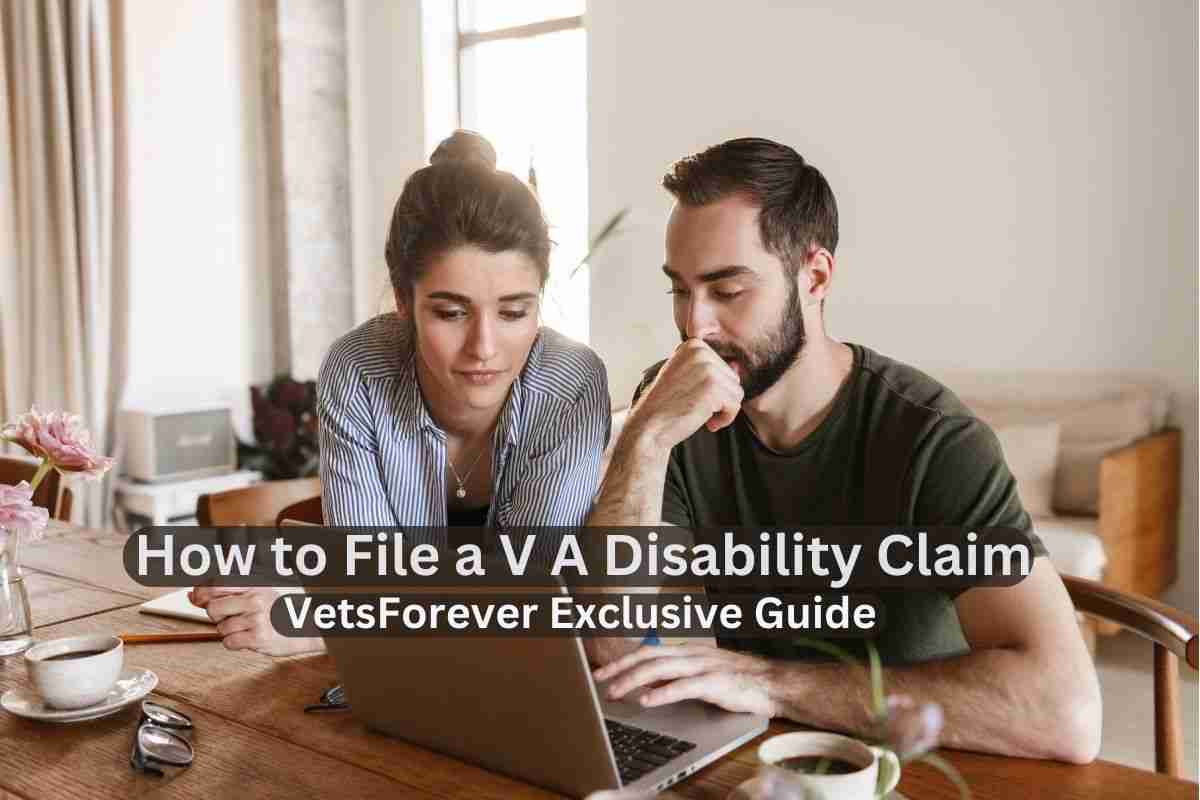
When veterans complete their service, a new chapter of their lives unfolds, often bringing forth unique challenges. It is crucial that they receive the medical support and comprehensive compensation benefits they truly deserve for their service.
A vital pathway is the process of filing a VA disability claim which veterans can attain financial relief and acknowledgment for their service-connected disabilities.
In this exclusive guide, we simplify the complexities of the VA disability claim procedure. We want to ensure we are helping every step of the way. We strive to empower veterans to secure the benefits that they have earned.
Overview Of When And How To File A Disability Claim
You can file a VA disability claim anytime you believe your existing medical condition resulted from injuries you sustained while on active duty. Several important documents are needed to support your fully developed claim to establish the connection between your disabilities and your military service. These documents help the VA assess your eligibility for disability benefits.
Key documentation includes:
- Service Records: These records provide evidence of your military service, including dates of enlistment, discharge, and any service-related incidents.
- Medical Records and Treatment History: Detailed medical records outlining your injuries, illnesses, and treatments are essential. These records help establish the link between your disabilities and your time in service.
- Statements from Witnesses (Buddy Letters): Statements from fellow service members who can corroborate the occurrence of incidents or conditions related to your disabilities can significantly strengthen your claim.
- Statement in Support of Claim: A personal statement that delivers your personal testimony on the occurrence of incidents or conditions during active duty that are related to your disabilities can significantly strengthen your claim.
- Disability Benefits Questionnaire (DBQ): A DBQ is a form completed by a healthcare provider that outlines the severity of your condition and its impact on your daily life.
- VA Claim Form (Form 21-526EZ): This form is the official application for disability benefits and collects essential information about your disabilities and military service.
- Nexus Letter: In some cases, a Nexus letter from a medical professional can establish the connection between your disabilities and your military service.
- Dependency Documents: If you claim benefits for dependents, you may need to provide birth certificates, marriage certificates, and other relevant documentation.
- Discharge Papers (DD-214): These papers provide information about your military service and are crucial for establishing eligibility.
- Medical Test Results and Imaging Reports: Any test results, X-rays, MRIs, or other imaging reports documenting your disabilities can strengthen your claim.
- Employment History: Details about your post-military employment, including any changes in your ability to work due to your disabilities, can be important for determining benefits.
- Social Security Disability Documents (if applicable): If you receive Social Security Disability benefits, these documents can help support your VA disability claim.
Ensuring your documentation is complete, accurate, and well-organized is vital to a successful fully developed VA disability claim. It’s also advisable to consult with a Veteran Service Officer (VSO) or a legal professional specializing in VA claims to ensure you have all the necessary documentation the VA looks for.
Eligibility Criteria For VA Disability Benefits
The availability of VA Disability Benefits is contingent upon meeting stringent eligibility prerequisites. Central to this qualification is the establishment of service-connected disabilities. You may be eligible if you meet both of these requirements:
- Both of these must be true:
- You have a current illness or injury (known as a condition) that affects your mind or body, and
- You served on active duty, active duty for training, or inactive duty training
- And at least one of these must be true:
- You got sick or injured while serving in the military—and can link this condition to your illness or injury (called an in-service disability claim), or
- You had an illness or injury before you joined the military—and serving made it worse (called a pre-service disability claim), or
- You have a disability related to your active-duty service that didn’t appear until after you ended your service (called a post-service disability claim)
The requirements above help the veteran demonstrate the direct correlation or a “Nexus event” between their military service and the onset or aggravation of their disabilities.
Types Of Disabilities
Military service can result in a wide range of disabilities, including physical injuries and significant mental health conditions stemming from the complexities of service. To review the list of specific disabilities and the criteria please refer to the 38 CFR Part 4 – Schedule for Rating Disabilities.
Additionally, you can refer to our high demand and most common disability articles for a quick reference. For instance, we have resources:
- PTSD VA Rating and Non Combat PTSD or (Mental Health)
- Everything you need to know about the PACT Act
- Tinnitus
- Back Pain and Radiculopathy
- Top 20 VA Disability Claims
Understanding The Disability Evaluation System
The VA’s Disability Evaluation System varies in complexity depending on your claim. Various tools and questions are designed to gauge the scope and severity of your disabilities.
For example, a C&P exam may measure your range of motion with specialized tools while other C&P exams may ask you a series of questions to determine your mental health or evaluate your responses for the severity of your conditions.
The results of these exams will help the VA determine the level of compensation that best corresponds to your unique circumstances.
Understanding the claims process enables veterans to effectively navigate the complex VA Disability Evaluation System.
A simple, yet very powerful tool a veteran can use is the VA Disability Calculator. This will help you determine your specific raw score and VA rating which will have a direct impact on your VA compensation and benefits. VA math has a unique formula they use to determine compensation. This tool makes it easy for you to get to the point with the various options that are unique to you.
How to Start The Claims Process
There are several options for filing a VA disability claim. Depending on your circumstances and disability, you will need to choose the appropriate avenue of approach:
- Online Application Through va.gov: You can file a claim with the U.S. Department of Veterans Affairs online through the VA’s website (va.gov). This method offers convenience and allows you to track your claim status online.
- Using The Paper Application (VA Form 21-526EZ): If you prefer a paper application, you can fill out and submit VA Form 21-526EZ and submit it through the mail to the following address: Department of Veterans Affairs Evidence Intake Center PO Box 4444 Janesville, WI 53547-4444
- Getting In-Person Assistance With A VSO or VA Accredited Law Group like VetsForever: If you need help navigating the VA, you can consult with a VA accredited lawyer like VetsForever or an accredited VSO to help you understand the process.
Navigating The VA Claim Process
Once you’ve implemented the claims process, your claim will go through six stages of claim including “Gathering of Evidence”. During this phase, the VA has a duty to assist you in gathering evidence to support your claim. But you are responsible for providing complete and accurate information to ensure a smooth claims process.
You will want to monitor your VA claim status and check for any updates.
Currently, one of the most convenient methods for verifying the status of your VA claim is to use the VA’s official website. However, you must create an account to check your VA claim status.
Understanding the Decision-Making Process
The VA evaluates your evidence and applies the VA Disability Rating Schedule to determine your disability rating. This rating determines the level of compensation you receive based on the current VA Disability rates 2023.
After filing a claim, there are three possible outcomes the VA Rating Officer can assign to your disability claim:
- Partial Service Connection: In some cases, the VA may partially grant service connection for specific conditions.
- Service Connection Granted: If the VA determines that your disability is service-connected, you will be granted compensation.
- Service Connection Denied: Your claim may be denied if the VA does not find sufficient evidence of service connection.
If you do not agree with the results or your denial from the VA, it is highly encouraged to thoroughly investigate the decision letter. The VA will inform you of what is missing and/or how they determined the reasoning for the decision. However, the fight is not over as you still have a options such as:
- File for an Higher Level Review (HLR) – this takes the claim as is for the VA to give it to a senior VA rater to evaluate the claim. It will take several months as this is a more in-depth process.
- File for a Supplemental Claim – You will need to submit additional evidence the VA is asking for, such as more medical evidence needed, to support your initial disability claim.
- File for an Increase – If you were underrated, such as given a 0% service connection, or significant time has passed, greater than 12 months, AND your conditions have gotten worse this is an option you may want to consider. The VA will reevaluate your medical history and evidence to determine if an increase is warranted.
The more veterans understand how the claims process works, the higher the likelihood that their claim will be approved. The key is to never give up!
Tips for a Successful VA Disability Claim
A successful VA disability claim requires careful preparation and persistence. Here are some tips to enhance your chances:
- Seek Assistance from a VSO: Getting advice from a seasoned professional can provide valuable guidance and support throughout the claims process.
- Be Persistent and Patient Throughout the Process: Filing a VA claim can be complex and lengthy. Maintaining patience and persistence is essential for a successful outcome. The personnel at the VA office are there to support and help you. Never be confrontational or short-tempered with them since they greatly influence the status and direction of your claim.
Following these guidelines will help you to successfully navigate the VA disability claims process and secure the benefits you deserve.
Resources and Support for Veterans
To further assist you on your journey, here are some additional resources and support options:
- VA Regional Offices and Contact Information: Find a VA regional office near you to receive personalized assistance.
- Veterans Service Organizations (VSOs): VSOs offer expert guidance and support in filing your claim.
- Legal Assistance for VA Claims: Legal professionals helping veterans obtain a VA Fully Developed claim can sometimes provide essential legal support.
- CHAMPVA: The Civilian Health and Medical Program of the Department of Veterans Affairs is a comprehensive healthcare program provided by the U.S. Department of Veterans Affairs (VA). CHAMPVA offers medical coverage to eligible family members of veterans, including spouses, children, and in some cases, dependent parents.
- TRICARE: This is a healthcare program that provides comprehensive medical coverage to eligible members of the U.S. military community that offers various healthcare options, including health plans, prescriptions, dental plans, and special programs tailored to active duty service members, retirees, and their families.
Veterans should not hesitate to leverage every resource at their disposal to pursue their disability claim to give themselves the greatest chance for success in being granted a high disability rating that provides maximum compensation.
FAQs
How do I file a VA claim step by step?
The VA claims process involves gathering evidence, submitting your claim, and undergoing evaluations. The fastest way to submit is through www.va.gov. Detailed steps can be found in the article above.
What is the 12-month rule for VA disability?
The 12 month rule refers to the time limit for filing a claim after leaving military service. If you file within 12 months of discharge, it’s presumed that your condition is service-connected.
What conditions do you need to file for VA Disability?
You can file for various service-connected conditions, including physical injuries and mental health conditions. Eligibility depends on the connection between your condition and your military service.
How far back can you claim a VA disability?
Generally, you can claim benefits for conditions that originated or were aggravated during your military service. The specific timeframe can vary depending on the circumstances.

